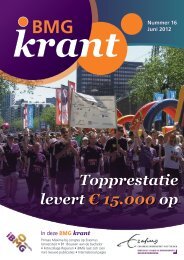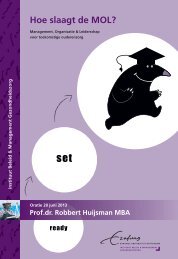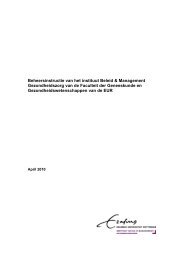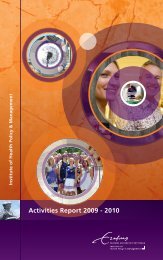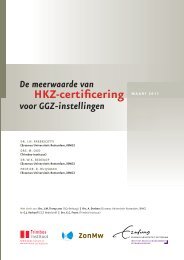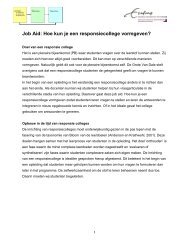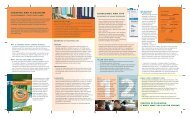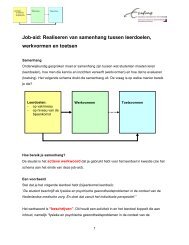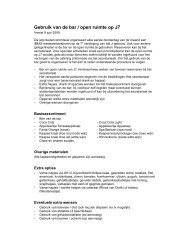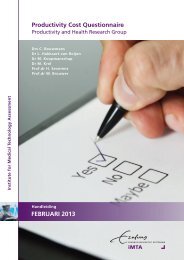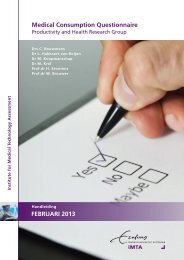Marten J. Poley - Erasmus Universiteit Rotterdam
Marten J. Poley - Erasmus Universiteit Rotterdam
Marten J. Poley - Erasmus Universiteit Rotterdam
- No tags were found...
You also want an ePaper? Increase the reach of your titles
YUMPU automatically turns print PDFs into web optimized ePapers that Google loves.
Short-Term and Long-Term Health-Related Quality of Life after ARM and CDH 61Table 4.5TACQOL Scores of ARM Patients and CDH Patients Aged 5-15 Years Compared withReference ScoresDomainMean scores (SD) Difference with reference group †(95% CI ‡ )ARM(n = 118)CDH(n = 39)Pain and symptoms 27.5 (3.5) 28.1 (2.9) -0.1 (-0.8 to 0.6) 0.5 (-0.6 to 1.7)Basic motor functioning 30.0 (4.0) 30.3 (3.0) -1.0 (-1.5 to -0.6) *** -0.7 (-1.5 to 0.0) *Autonomy 30.6 (3.2) 30.9 (2.5) -0.8 (-1.1 to -0.4) *** -0.4 (-1.0 to 0.2)Cognitive functioning 29.0 (4.8) 28.3 (4.2) -0.5 (-1.2 to 0.2) -1.2 (-2.4 to -0.1) *Social functioning 29.3 (3.7) 29.9 (2.3) -0.7 (-1.2 to -0.3) ** -0.1 (-0.8 to 0.6)Global positive emotional 14.6 (2.3) 14.8 (1.8) -0.4 (-0.7 to 0.0) * -0.2 (-0.8 to 0.4)functioningGlobal negativeemotional functioning11.9 (2.5) 12.4 (2.3) 0.2 (-0.3 to 0.6) 0.7 (0.0 to 1.5)ARMCDHThe English version of the TACQOL is available on request.*Significant at P < 0.05**Significant at P < 0.01*** Significant at P < 0.001†Reference scores (n = 1,311) were derived from a random sample of Dutch children (aged6-11) in the general population after exclusion of all children with any (parent reported)chronic condition. 16 The means and standard deviations of six age and sex matched groupswere combined.‡95% confidence interval for the difference between the group means.Table 4.6SF-36 Scores of ARM Patients and CDH Patients Aged 16 Years and OlderCompared with Reference ScoresDomainMean scores (SD) Difference with reference group †ARM(n = 127)CDH(n = 52)(95% CI ‡ )Physical functioning 92.8 (14.3) 93.7 (14.0) -0.3 (-2.7 to 2.1) 0.6 (-2.8 to 4.0)Role-physical 87.6 (28.5) 90.2 (28.8) 1.2 (-4.2 to 6.6) 3.8 (-4.1 to 11.7)Bodily pain 78.2 (17.0) 83.5 (11.4) -2.7 (-6.3 to 1.0) 2.6 (-2.8 to 8.0)General health 75.3 (22.1) 78.5 (17.7) -2.9 (-6.4 to 0.7) 0.3 (-4.7 to 5.2)Vitality 68.0 (17.2) 68.1 (21.7) -2.7 (-5.9 to 0.5) -2.6 (-7.4 to 2.2)Social functioning 89.9 (15.6) 91.1 (20.3) 2.1 (-1.5 to 5.6) 3.3 (-2.2 to 8.8)Role-emotional 90.1 (26.8) 90.9 (28.3) 4.7 (-1.0 to 10.4) 5.4 (-3.1 to 14.0)Mental health 78.3 (15.1) 77.4 (19.4) -0.4 (-3.4 to 2.5) -1.3 (-5.8 to 3.1)Physical component summary 52.2 (7.7) 53.7 (5.2) -0.7 (-2.1 to 0.7) 0.9 (-1.2 to 3.0)Mental component summary 52.5 (8.0) 51.9 (10.9) 3.6 (1.8 to 5.3) ** 3.0 (0.3 to 5.7) *ARMCDH***†‡Details on the SF-36 are available through http://www.sf-36.org/demos/SF-36.html.Significant at P < 0.05.Significant at P < 0.001.Reference scores for the eight 'individual' domains were derived from a Dutch generalpopulation sample, aged 16-40. 'n' was estimated at 551 on the basis of the fact that thetotal sample, aged 16-94, contained 1,742 people. 34 To obtain reference scores for thesummary scales, we had to rely on a US general population sample, aged 18-44 (n =2,765). 3595% confidence interval for the difference between the group means.





